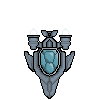
I've been testing a few different kinds of lights for the game. At the left of the image is a large white light that's illuminating the blue ocean. In the middle is a line light that will be used for the laser weapon in the game. The light in the bottom right is actually colored slightly orange, but the water turns it green. It also has a shaped bloom effect.

The lighting system works by drawing light sprites into two separate surfaces. One is multiplied with the original unlit image and the other is added to the result. This allows lights to color the surrounding environment as well as cast bloom effects. This image shows the raw buffers from the screenshot above without any game objects. The light sprites are generated procedurally although I'm experimenting with precomputing them for the final game.


